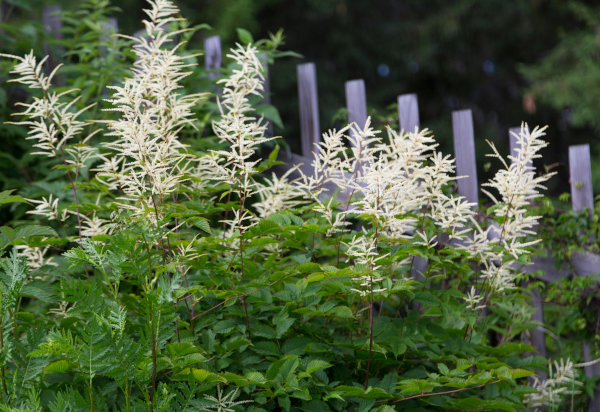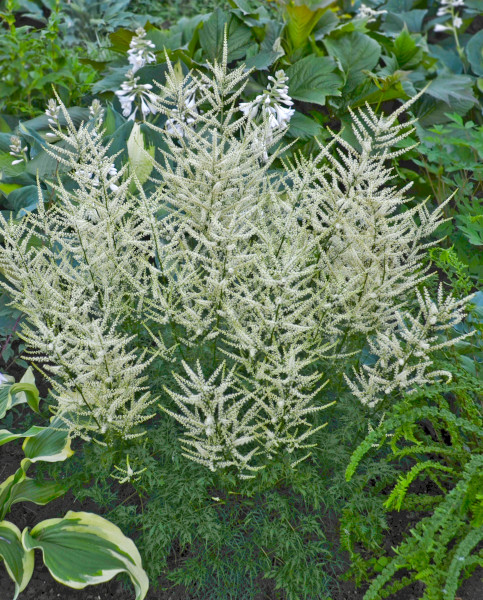How to grow Aruncus
This clump-forming perennial member of the rosaceae family hails from moist woodlands throughout the northern hemisphere. It is cultivated by gardeners for its attractive, deeply divided foliage and elegant, feathery plumes of tiny cream flowers.
Aruncus dioicus has separate male and female plants; the male has creamy white flowers, while the female has more pendent, greenish flowers and produces interesting-looking seedheads (it is important to note here that the seedpods are toxic to humans and animals). It is not generally apparent whether a plant is male or female until it flowers. A. aethusifolius is not split in this way; all plants have both male and female parts and can be expected to produce creamy white flowers.
Aruncus can also be known by the common name of goats beard. It is not to be confused with false goats beard (astilbe), which although similar, is a different plant altogether belonging to the Saxifragaceae family.

Key Information
Soil pH
Position
Hardiness


Where to plant Aruncus
For best results, plant in autumn or spring. An autumn planting can be done by those gardening in mild conditions (and broadly speaking, this is the southern half of the UK). For those liable to cold winters, it is best to wait until spring (generally the northern half of the UK). Planting can also be carried out in summer, though be prepared to water regularly.
Aruncus is ideal for a moist border or woodland garden, where it can be expected to spread slowly by underground rhizomes to form an attractive drift. It can also be grown in a container, providing it is kept well-watered. Some of the dwarf varieties are particularly good for this.
How to plant Aruncus
- For planting in the garden, dig the soil area removing any large stones and weeds and breaking up any lumps. Mix in some organic matter such as manure or garden compost. Rake level and firm with your heels. Rake level again.
- Water plants well and allow to drain before planting.
- A good tip is to dig a hole twice the size of the root-ball. Fill with water and allow to drain before placing in the plant.
- Place the plant in the hole, ensuring the top of the root ball sits level with the surface of the soil. Too low and the plant may rot, too high and the roots can dry out.
- Backfill with soil and firm in gently with your foot.
- Soak well with water.
- Mulch around the base with well-rotted organic matter.
- For planting in containers, first choose an appropriately sized pot. The best practice is to start just a few centimetres larger than the rootball and increase in size every year or two. Always ensure there are plenty of drainage holes in the bottom.
- If you are using a large or heavy pot, it can be a good idea to fill and plant it in situ to save yourself the trouble of moving once full.
- Use a good quality potting compost with some horticultural grit mixed in, and, if not already present in the compost (check the description on the bag) some slow-release fertiliser granules.
- Start by partially filling the pot with compost; enough so that when placed on it the upper surface of the root ball is about 3cm lower than the top of the pot.
- Infill all the space surrounding the root ball with compost, firming down with your fingers then adding a little more so the plant is held tight.
- Pick up the container and lightly tap on the potting bench or ground a few times to help further settle the compost around the plant.
- Soak well with water.
- A mulch with horticultural grit will look attractive and help to prevent a ‘cap’ or crust forming on the top of the compost (something container plants can suffer due to the artificial nature of their watering).

How to care for Aruncus
Pruning and Deadheading
If self-seeding is not wanted, cut back spent flowers before they have a chance to set seed.
Prune the whole plant down to just above ground level in autumn.
Watering
Aruncus enjoys consistently moist soil and will visibly suffer (with crispy brown foliage) if allowed to dry out.
Aruncus in the ground will need a good watering in on planting and then regular soakings until established. After this it should need watering only in very hot, dry conditions providing it is in moist soil and mulched annually (see below). Aim for consistently moist but not soggy soil – allowing the top few centimetres to dry out between soakings is a good rule of thumb to avoid overwatering. To check this, wiggle your finger down into the soil until you hit a cool, damp bit.
Container-grown aruncus needs more attention as it has less access to water. Again, aim for consistently moist but not soggy compost using the ‘finger check’ technique above. Be aware that in hot, dry weather containers may need watering every day (particularly smaller containers which can dry out very quickly). From mid-autumn, the British climate tends to take over watering needs, though do remember to step in in the event of an unseasonably dry spell.
Feeding
On healthy, fertile soil, a mulch of well-rotted organic matter (i.e., a layer of leaf mould, manure, or garden compost applied to the soil around the plant) should provide enough nutrients for your aruncus. This has the added benefit of suppressing weeds and locking in moisture. Mulch when planting, and then again each spring.
If you garden on poor soil, or your aruncus looks in need of a boost, applying a general purpose granular feed to the surface of the soil and lightly working in (known as a ‘top dress’) can reap benefits. Do this when you’re mulching – first apply the top dress, then cover with the mulch.
Container-grown plants are different, as they rely solely on the gardener for nutrition. Get off to a flying start by making sure you use a good quality compost, then throughout the growing season (March to September) apply a fortnightly liquid feed.
Cold Protection
Aruncus is as hardy as it gets and will withstand even the harshest of UK winters without the need for additional protection.
Pests and Diseases
Aruncus is largely problem-free apart from the aruncus sawfly which, during its larval stage, can eat through a significant proportion of the foliage. While unsightly, this need not cause too much alarm; plants will usually recover and are not necessarily affected again in subsequent years.
As ever, we encourage small populations to be tolerated as they form part of a healthy, balanced garden ecosystem. Encouraging natural predators into the garden is the best line of defence, which includes birds and ground beetles. Removing the larvae by hand is another sustainable method of control – look out for them from May onwards.
How to propagate Aruncus
While aruncus will often naturally self-seed, it can be tricky to use seed as a propagation method as germination can be erratic. Far simpler is to lift and divide established clumps in autumn or early spring. As well as producing new plants this has the added benefit of reinvigorating existing clumps. Allow 2-3 years recovery time between divisions.
- Choose a day when the soil is not frozen or waterlogged.
- Identify new clumps arising from rhizomes sent out by the parent plant.
- Sever the rhizome and dig the clump out of the ground.
- Replant where desired or pot up to grow on for use elsewhere.
- Water well until fully established.
* Many plants carry Plant Breeders Rights and cannot be propagated for commercial purposes.
Common Aruncus questions
- Will aruncus grow in shade?
Aruncus does best in part sun/ part shade conditions and will struggle to thrive in full shade. For this, try alternatives like sarcococca, brunnera, galium, alchemilla, or acanthus - Do you cut back aruncus?
Yes, this is a herbaceous perennial that can be expected to die back for winter and regrow in spring. Follow our ‘Pruning and Deadheading’ advice above on when best to cut back. - Is aruncus poisonous to dogs?
The seedpods of dioicus are known to be toxic to people and animals.




